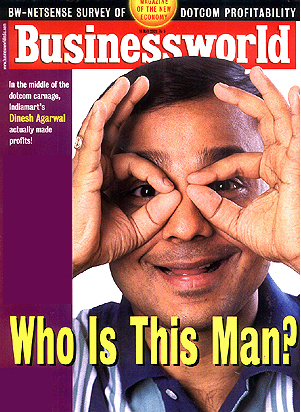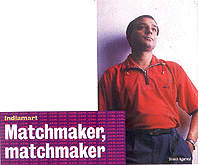Business World,
 Dotcom Survivors
Dotcom Survivors
The past nine months have seen hundreds of high profiled dotcoms across the world bite the dust. But in the midst of carnage, some start-ups have managed to survive- and even flourish. So, which are the dotcoms that actually did things right while their peers were busy burning cash? The first BW-Netsense survey throws up 21 survivors who were marching ahead even as the dotcom carnage was taking its toll of their peers. How we identified these dotcoms- and the lessons one can learn from them.
Clear Survivors
INDIAMART – It began as a query-forwarding service for Indian exporters in 1996. Now, it is trying to make a go at global outsourcing for its clients.
IndiaMART – Matchmaker, Matchmaker
Till last year the man on our cover barely knew the meaning of the term VC. The family business was petroleum trading. Thirty-one-year-old Dinesh Agarwal is an unlikely dotcom entrepreneur yet, at one point, in mid-2000, VCs were crowding into his office in a congested part of east Delhi. The slightly built managing director of Indiamart- a B2B portal for exporters- looks amused as he recounts his experience.
Agarwal had a hard time telling the VCs that online auction was not about to take off in a hurry in India. For one, there was no payment mechanism in place. Then, suppliers and buyers conducting global transactions worth millions without meeting once needed sturdy guarantee systems in place.
The high-risk, high-reward existance oriented VCs who were scouting around for an instant scalability business model were not impressed. But Agarwal, with his family business to bank on, did not lose much sleep over it. Today, Indiamart is an ideal example of the net-based entrepreneurial spirit. And a profitable one, at that. On revenues of Rs 135.4 lakh, it declared a net profit of Rs 6.2 lakh in FY 2000 that is expected to touch Rs 14 lakh this year (revenues: Rs 287 lakh).
 Indiamart founder Dinesh Agarwal perhaps sums up the temperament of these hardy survivors: “We did not base our plan on any external funding posssibilities. Investments are made only after the cheques come in.” The bottomline: since easy money wasn’t taken to be a given, capital wasn’t squandered.
Indiamart founder Dinesh Agarwal perhaps sums up the temperament of these hardy survivors: “We did not base our plan on any external funding posssibilities. Investments are made only after the cheques come in.” The bottomline: since easy money wasn’t taken to be a given, capital wasn’t squandered.
A chance query from a cousin about the Chicago Mercantile Exchange, which Agarwal found on the web, triggered off the idea of an online directory service. ASSOCHAM provided the content and Indiamart was up and running, working as a sort of online matchmaker for Indian suppliers and global buyers. It charges Rs 5,000 for a single page of web presence with the guarantee of 5 enquiries a month. About 75% of its revenues come from this. Currently, Agarwal says, Indiamart has 70,000 listed businesses (like handicrafts and apparel), 1,000 B2B catalogs and generates about a lakh queries a month. He claims to have generated over Rs 400 crore worth of business for his clients last year- most of it for the travel industry. Not surprisingly, he is now planning to spin off online reservations as a separate business.
Another logical extension is an online auction portal. Agarwal has already tied up with a Geneva based supplier verification company, SGS, to verify products and orders before shipment from India and approached rating agencies like Icra and Crisil to enable payments through escrow accounts.
Agarwal has steered clear of advertising. Instead, high visibility has been achieved by pushing his site with search engines. Although other B2B sites like Indiamarkets have the same model, Agarwal thinks he can do better for two reasons: his existing contact database of 60,000 suppliers and the sound relationships he has built in the last five years, which newcomers are going to find difficult to replicate. Agarwal now plans to join an MBA course. Would that make him a more stereotype dotcommer?

